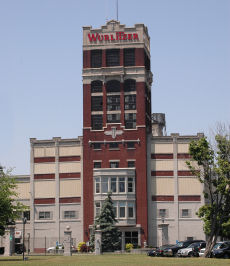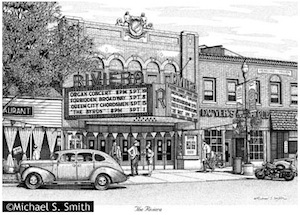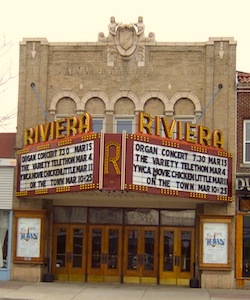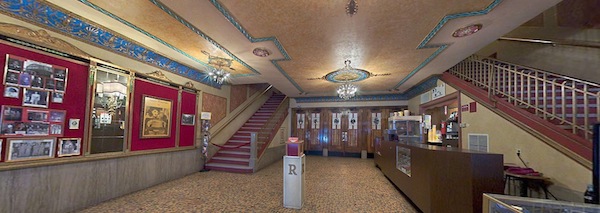History
With thanks to Bob Sieben, Riviera Theatre historian and long-time volunteer.The Riviera Wurlitzer, 3-manual, 11-rank - Opus 152, was delivered directly from the factory on November 19, 1926 in time for the grand opening of the theatre on December 30, 1926.  Because of the theatre's proximity to the factory, about 4 miles, the organ was the ideal marketing tool for the Wurlitzer management, with theatre owners from many parts of America and the world visiting North Tonawanda to view and hear a prime example of organ installation. The Riviera Theatre of North Tonawanda was even billed as "The Showplace of the Tonawandas". Silent movies were still in their heyday with soundtracks an unknown mere whisper away. At this time, 1926, the importance of good musical accompaniment was still recognized by cost-conscious cinema managements as a major factor in the financial success of their theatres.
Because of the theatre's proximity to the factory, about 4 miles, the organ was the ideal marketing tool for the Wurlitzer management, with theatre owners from many parts of America and the world visiting North Tonawanda to view and hear a prime example of organ installation. The Riviera Theatre of North Tonawanda was even billed as "The Showplace of the Tonawandas". Silent movies were still in their heyday with soundtracks an unknown mere whisper away. At this time, 1926, the importance of good musical accompaniment was still recognized by cost-conscious cinema managements as a major factor in the financial success of their theatres.
The new theatre, originally named as New Rivera (probably because of its proximity to the Niagara River), was built throughout 1926 by the Yellen family from designs by architects Leon H. Lempart & Son, was modeled on Italian Renaissance style. Interior decoration was undertaken by the Rochester Studio of William M. Lusk, artist Ferdinand Kebely. To match the style elected, the decoration of the organ console was done by one of Wurlitzer's Band Organ artists.
On opening night, Thursday, December 30, 1926, the organist Fred Meyer accompanied "Upstage", starring Norma Shearer, "The Mona Lisa", in early Technicolor, a comedy short and newsreel, as well as a short solo recital. Attending this $1 a head 'gala event' were the Mayors of both Tonawandas. New York State Governor, Alfred E. Smith, and movie producer, Cecil B. DeMille, both sent messages of congratulations.
Early years at the Rivera saw regular use of the organ with featured organists Al Bollington, "Dusty" Rhodes, Jack Ward and Art Melgier. Because of its fine stage and 'fly' roof, the Rivera also produced Vaudeville and other musical shows as well as the latest movies during the early years. During the early 30s, as soundtracks became more common and the theatre introduced a sound system for the new showings, the organ was gradually restricted to occasional silent movie re-runs and special concerts. In the depression period the theatre management changed hands and its name changed to 'Shea's Riviera' in an attempt to appear more upmarket. Although still a popular venue for moviegoers, hungry for entertainment during an otherwise lean period, there was little demand for the organ which gradually fell into a state of disrepair with little or no maintenance.
By the middle of WWII only part of the Great Manual was capable of being played. Organ builder and restorer Carlton Finch, with his father Harry, began work on repairing the instrument, including cleaning out fallen plaster and dust from electrical contacts. The first public concert for ten years was given by Carlton Finch on 'D' Day 1944. The Finch's continued work and very little public exposure was given to the organ until the early sixties except for a short period of 'teenage dance parties' in the late fifties.
On March 18, 1962, the Niagara Frontier Theatre Organ Enthusiasts sponsored Carlton Finch for a special concert and subsequently held one or two concerts annually . With the local club helping out with restoration work, the theatre joining the Dipson Theatre chain, there was renewed interest in the organ as an integral part of the theatre.
From 1967 the concerts became more regular, following a special mid-week evening concert, leading to monthly concerts that continued even during the closure of the theatre as a movie cinema. Different owners did little to improve the future prospects of the Riviera until the organ enthusiasts raised the finance to purchase the organ. What had been a regular effort at restoring the organ now became joined by the need to do more for the fabric of the building. Volunteers set to and made gradual improvements to the entire project.
By 1975 the organ had grown to 16 ranks of pipes, the console refurbished and major concerts with silent movies arranged. The fiftieth anniversary of the theatre's opening was celebrated with a concert by Frank Olsen.
| The Riviera was included on the Register of Historic Places by the US Department of the Interior, April 22, 1980. This prompted a 'Save the Riviera' benefit concert in June, 1981 as the future of the theatre was still uncertain. As an attempt to keep the theatre 'alive' the club agreed to sell the organ back to new owners Saled Properties in 1982. Owner control kept changing and, although the club still had good access to the organ in off hours, it eventually became clear in 1988, when the theatre once more came up for sale, that the club would have to consider attempting ownership. | 
Print available from: www.mssgraphics.com |
A 'gentleman's agreement' with the owners, a fund-raising drive and plenty of optimism led to a deal on February 14, 1989 when the Niagara Frontier Theatre Organ Society purchased the theatre and its Mighty Wurlitzer.
In the intervening years the name of the owners has changed to the Riviera Theatre & Organ Preservation Society and restoration work has proceeded continuously. The building is now referred to as the Riviera Theatre & Performing Arts Center and future expansion is planned. A neighboring building on Main Street was purchased after RTOPS received a generous grant from the State of New York and it is planned to make this site an important extension to the facilities of the Riviera Theatre. The organ received a $60,000 makeover in 2008, bringing it back to its 1926 specification, with re-voicing making it one of the finest Wurlitzers in the world, especially unique for being situated in its original home theatre.
 |
Changes in management in 2006 brought a renewed vigor to the programming and use of the theatre, includng a lift to the quality of organ concerts. The future for theatre and Mighty Wurlitzer look brighter than ever, with more donors coming forward to have their names included on the theatre's list of Star Sponsors. ADD YOUR NAME TO THE LIST -DONATE TODAY! |


